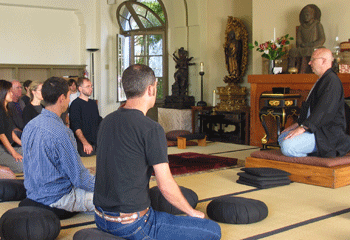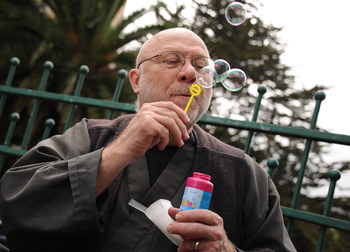Article by Kogan Sheldon, Program Assistant at San Francisco Zen Center
A Shamatha Sitting is a more relaxed form of a one-day sit that is excellent for beginners and for anyone who needs a gently nourishing day of meditative practice. With a focus on joy and abiding in the moment, our Shamatha Sittings are often led by Tokuden Shinki Mark Lancaster.
 As a Zen priest and the Director of People Development at San Francisco Zen Center, Mark Lancaster is one of the most available teachers at City Center. We’ve engaged with him on the front steps of 300 Page Street, in the courtyard, in the residents’ lounge, at breakfast, lunch and dinner in the dining room. Climb some stairs to the second floor of the Conference Center, and he can be found in his colorful and welcoming office at the rear of the building. Behind the labors of Human Resources policy development, numerous conferences and meetings, and his steady attention to the details of People Development, Mark is a quiet Buddhist scholar and guiding presence for our daily Zen practice. He agreed to field a few questions.
As a Zen priest and the Director of People Development at San Francisco Zen Center, Mark Lancaster is one of the most available teachers at City Center. We’ve engaged with him on the front steps of 300 Page Street, in the courtyard, in the residents’ lounge, at breakfast, lunch and dinner in the dining room. Climb some stairs to the second floor of the Conference Center, and he can be found in his colorful and welcoming office at the rear of the building. Behind the labors of Human Resources policy development, numerous conferences and meetings, and his steady attention to the details of People Development, Mark is a quiet Buddhist scholar and guiding presence for our daily Zen practice. He agreed to field a few questions.
Kogan: We’re looking forward to the next Shamatha Sitting you will lead at City Center. Would you describe how Zen and the ancient Buddhist shamatha are related?
Mark: Shamatha means dwelling in tranquility. Zen (Dhyana) implies a state of absorption or connection between subject and object. This state of immediate connection is also a state of Prajna, or Wisdom. Like a lamp and a flame they are intertwined. Zen, the act of quietly sitting, involves both activities—Shamatha, dwelling in tranquility, and Vipassana, clear seeing.
As an American practitioner, I feel that our culture lends itself to psychological construction and analysis, intellectual and conceptual creationism, and self-criticism. Our sharp self critic is particularly difficult for many of us to work with. It tends to solidify our intellectual projections in unhelpful ways. The ground remains unprepared. Therefore, I like to concentrate on one aspect, Shamatha.
Historically, Shamatha was seen as a necessary ground for the development of concentration and wisdom—a suitable mind-body that was soft, pliable and “juicy.” Imagine a farmer softening the ground with water, fertilizing and preparing the earth for planting. Unless the preliminary work is done with care, the crops will be stunted or die.
Shamatha is linked to the Brahmaviharas (sublime ways of being), which were in turn linked with the Jana (Dhyana) practice: first softening mind and body, creating a sense of ease and enjoyment, and then allowing the pleasure to dissipate until a focused equanimity shines.
The Sunday Shamatha sittings are preparing the ground. Of course, we are the ground!
Kogan: Did you take up the path of calm abiding, or did you realize that you were already on it? I guess what I want to know is, was it difficult to begin and maintain shamatha practice?

Photo by Susana Millman
Mark: By observing where I got stuck and suffered, I realized that I could not think and project my way out of Samsara, or the wheel of attachment to conditioned existence. Instead of solving the problem, I had to become the problem, manifest the difficulty in my body and mind. In order to relate, I needed to soften and accept.
The difficulties arose in the thought that I was not really doing anything. Nothing was being accomplished. This actually is a true insight! Once I had passed that gate, then sleepiness and vagueness arose. When we are not working on ourselves as a project, we get bored and fall asleep. So then I asked, “How do we engage with our lives without falling asleep or getting angry?” I had to explore more deeply the situation itself, how subject and object were related, in order to see the vivid quality of form as not being different than emptiness.
Kogan: Being at the hub of people-relations in your work here at City Center and also a great Giants fan, would you say something about your experience with calm abiding in the midst of action?
Mark: Calm abiding is not inaction or quiescence. This is a difficult life and the Giants often lose a game! Vivid experience means seeing the wild magic of all the forms expressed in life, without attaching or investing in ways that are distorted and painful. Now, pain is just pain, but My Pain is an idea of pain that can cause deep suffering if I get lost in it. Letting go, I cheer and cry and laugh. Something happens. Win or lose the game goes on!
Kogan: Is there anything you would like to add?
Mark: Buddha described his state as one who had appeased his dispositions. Often, we concentrate on conquering and subduing, making better. Making peace with ouselves, appeasement, is our creative relationship with the functioning aspect of existence. Form, Sensation, Perception, Formation, Consciousness. Just that.
__________
See Shamatha Sitting on our website for details.











